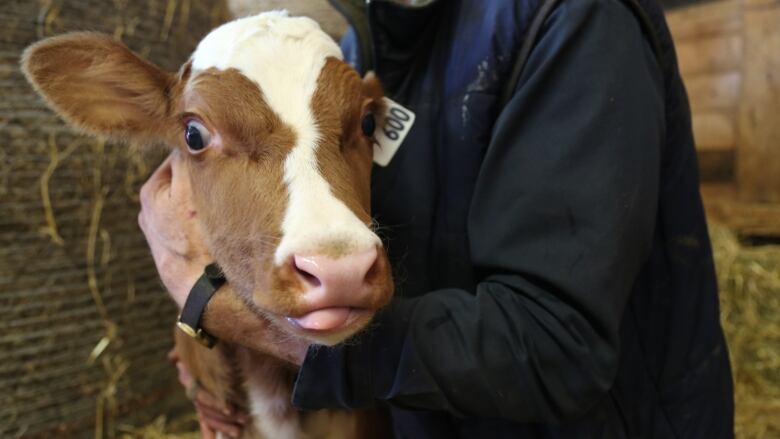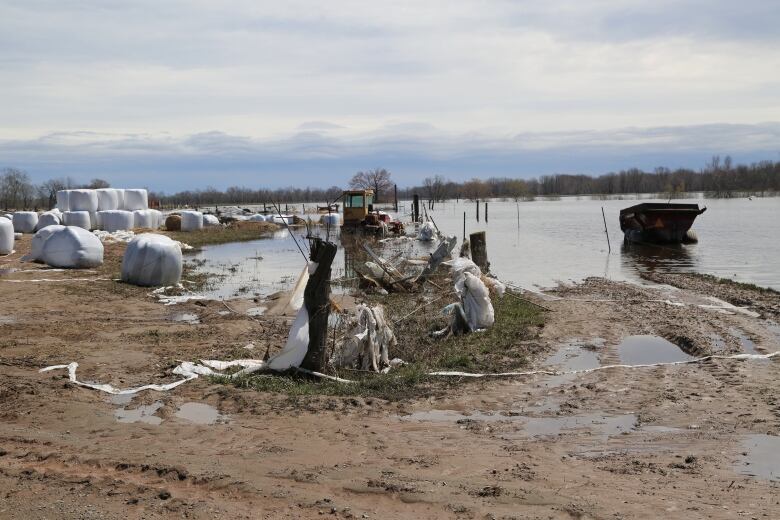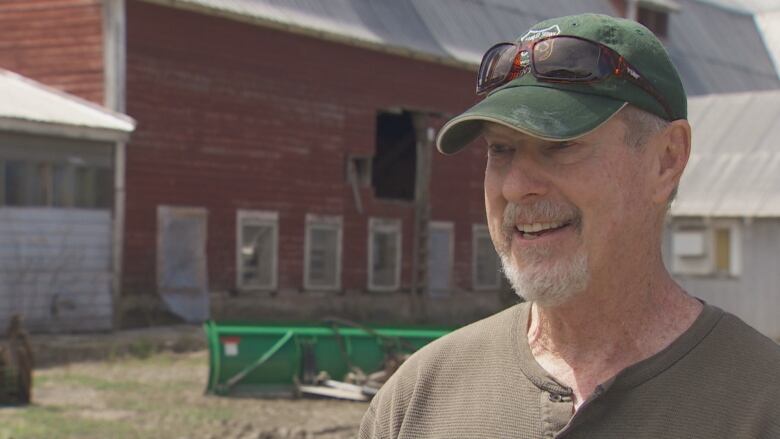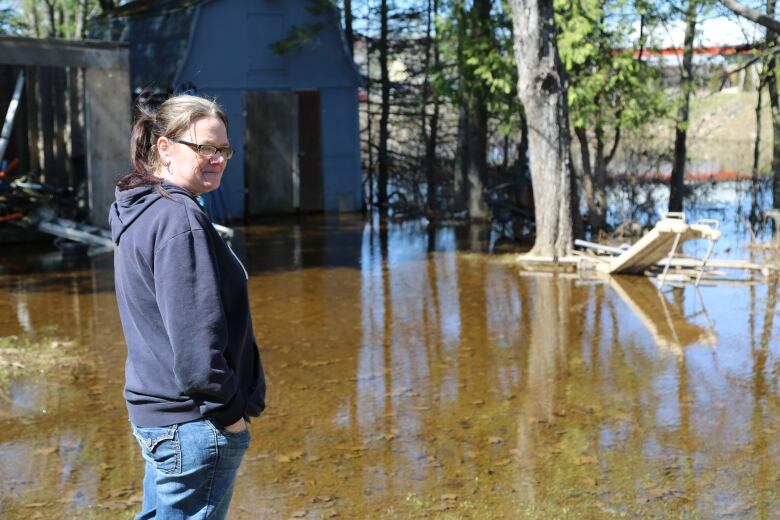Out of hell, 'High Water': flood gives birth to inspiration
Stories of human and animal loss and life in the flood of 2018

As George Bourque drives into his farm on the edge of Fredericton, he's met by empty canoes, toppled trees and a mass of water that just a few days ago required a boat or tractor to get through.
For days, Bourquehas been going back and forth between the farm, where water from the St. John River spilled into the cow barn, and the Fredericton Exhibition grounds, where his 42 cows found shelter.
"It's a lot of stress on them, it's a lot of stress on us," said the 74-year-old farmer, who livesonBourque'sLane, off the Lincoln Road.
This is Bourque's story, and the story of a couple of others anecdotes of death, birth,kindnessandresilience in the flood of 2018.
- 'It's like they blew up': Family devastated as 'heirloom' cottages smashed to bits
- Upright and intact cottage floats across province's largest lake
- The house is safe. Now what do you do with all of those sandbags?
What started out as a St. John River swollen from the usual snow melt in the north turned, almost without warning, into a historic flood in the south. High water quickly overtook homes, businesses and recreational properties from the capital city all the way to Saint John.
As the water rose, the flood displaced more than 1,600 residents and hundreds of animals.
Behind the cow barn, Bourque's 300 acres look like an extension of the St. John River, meant for boats and kayaks, not for hay bales and farm machinery.

Last week, water levels in the barn crept up to20 inches (about 50 centimetres) four inches more than the building can handle before the animals and their raised beds are in water.
- Historic church struck by lightning, endures flooding year after year
- Worst floods in New Brunswick history: how 2018 compares
- 3 men charged after alleged looting of flooded home in Maugerville
"That extra four inches made it a lot more challenging," Bourque said. "When it gets above the beds they're right in the water, they have no place to go.
He started moving the animals into a barn at the Fredericton Exhibitiongrounds around 8 p.m. last Wednesday and finished at 2 a.m. on Thursday.

Bourque has been at the exhibition grounds every day, doing his regular chores, milking and feeding hiscows, which have shared the space with almost 200 other animals and several farmers from the area.
Cows aren't used to the upheaval, Bourque said.
"If you take an ordinary person and bring them out of their common situation and put them in a situation that was difficult for them, which they've never been in before, it's stressful."

During the floods of 1973 and 2008, Bourque was also forced to move cattle. He had more cows then, but the floods seemed less prolonged.
"Years ago, the flood came up and went down," he said. "Now, it comes up and stays."
After moving cows to safety three times now,Bourqueis ready to retire.
But he's grateful for the help he's received during this latest flood.
Spreading kindness
Flood victims of 2018 almost universally describe the calamity along these lines: "The worst of Mother Nature but the best of humankind."
The New Brunswick flood has drawn attention from around the world, with volunteers everywhere lending their hearts and their hands to help.

Robert Sipes sold his smallfarm in Arkansas about a year ago and was travelling around North America when he happened upon New Brunswick.
"The plan a week ago was to go to the shore and visit Canada and spend some time touring around," he said.

But ashe made his way through the province, Sipes was shocked by what he saw.
"I started seeing bridges that were closed and flooding and wasn't aware what was going on."
He quickly learned his help was needed, so hestepped in. Over the past week, he's been helping Bourque.
'As long as they need me'
"The amount of devastation is a little overwhelming and incredible." Sipes said. "I don't know how you recover from something like this. We just pull together and do the best we can, I suppose."
Sipes hasbeen milking cows, shovelling hay, and cleaning up a barn that wasfilled with water and manure.
"We live in a time where things are a bit difficult and there's a lot of animosity amongpeople and a lot of division," Sipes said. "It's things like this that bring us together."
Right now, Sipes is living in a small trailer at the exhibition grounds in Fredericton. He plans to stay as long as he's needed to help Bourque'sfarmget back up and running again.
"Whether we're 3,000 miles apart or just living across the street, we're all neighbours," Sipes said.
Death and birth

Each morning of the flood,farmer Bourque put on his rubber boots to deal with high water the high waterat his farm and, eventually, high water of another sort, at the Fredericton Exhibition.
One of the cows Bourquehad to load on a trailer and haul out of her home was set to give birth any day.It was just a few days after the cow's arrival atthe exhibition grounds, that she delivered her calf. A welcome bit of life amidthe destruction.
But during the evacuation, the motherpulled a muscle. With herinjury, the stress of the move and going into labour, the cowcouldn't recover, Bourque said.
She lived long enough, however, to give her calf three days' worth of milk enough for the newborn to survive without her before she had to beeuthanized.
Bourquenamed the calf High Water.
"There was a group of people there milking and I said, 'I've got to name my calf, what's a good name?" he said. "One of them says, 'What about High Water?'"
Almost all of Bourque's cows are now back at the farm.High Water is set to arrive on Monday.
A display of resilience
The flood destroyed homes and cottages,with some of the most destructive water smashing buildings to pieces in the Grand Lake area and sweeping others off their foundationsinto strangers' yards.
The flood also contaminated water and closed more than 150 provincial roads,including part of the Trans-Canada Highway between Fredericton and Moncton.

For 11 days, Shawna Jardine and her boyfriend, Brad Morehouse, got to work in the morning by wading through water in their driveway in Fredericton's McminnimanCourt, hopping into a canoe lent to them by their neighbour, and paddling across the road to their vehicle, which they parked overnight in a dry lot.
An experience nothing short of "cold and horrible," Jardine said.
"There were days the wind was really bad, so the water was very, very rough. We couldn't even leave the house. We just went in circles."
When the couple did reachdry land, they had to change clothes inside their truck.
"We still have to pay our bills, we still have to work, we have kids, we have a home, we just do it."

Then they would do the same thing all over again at night, sometimes juggling a load of groceries.
This was the Miramichi native's first time canoeing and, she hopes, her last.
"We're sick of canoeing, we're sick of walking through water."
Most people onMcminniman Court are used to flooding, which happens every spring, but they hadn't seen anything like this in a while.
"When we went out on our back deck and we saw the river running through our neighbour's backyard, we knew it was coming and it was coming fast," Jardine said.
A need to behome

About 30 families were forced to leave their homes in the McMinniman Court area.
Jardine refused to be one of them.
"We just had to be here to know what was going to happen," she said. "We were scared. Ifwe left, what were we coming back to?"
Our stairs are floating in the basement, our furnace is floating, our water heater is floating, our wood stove is floating.- Shawna Jardine, Fredericton
She and her family endured almost two weeks of worry about whether the water would keep rising and destroy their possessions or, worse, force them to leave their home.
"We were scared we were going to lose everything," she said. "We were probably about six inches away from the water hitting our main level."
Outside Jardine'sliving-room window, her neighbours' washers and dryers floated by, along with bits of wood, sleds, spare tires, planter boxes and swing sets.

Things belonging toneighbourhood children bobbed around in the water,she said.
"Now it's kind of, 'Go around the neighbourhood and find your stuff.'
"Everybody's pretty emotional."
Home turns into flood zone
Now that water levels have come down, the cleanup can begin, Jardinesaid, but it's going to take several months for things to get back to normal.
When the flood started and the water came fast, the couple raced to bring everything from the basement to the main floor. They jammed 40 empty boxes with Christmas decorations, tools and souvenirs and other objectsand piled them all in the dining room.
"Unfortunately, we couldn't get everything up in time," said Jardine, referring to the beds and dressers left behind in the basement, which is still full of water.

"Your cleaning supplies, paint, that's all still downstairs, floating our stairs are floating in the basement, our furnace is floating, our water heater is floating, our wood stove is floating."
Outside, the lawn has turned to mud, the patio furniture now dilapidated,and the fire pit non-existent.
Jardineestimated the flood caused at least $20,000 worth of damage.
"A house can only handle so much floodwater year after year and structural damage," she said.

Jardinesaid the images from this year's flood will always be at the back of her mind, especially in spring. She worries the high water will become an annual catastrophe.
But for now, all she and other flooded New Brunswickers cando is pick up what wasn't washed away.
"We're always going to wonder, we're always going to be on alert," Jardine said. "The next step is to prepare ourselves even more."














_(720p).jpg)


 OFFICIAL HD MUSIC VIDEO.jpg)
.jpg)



























































































